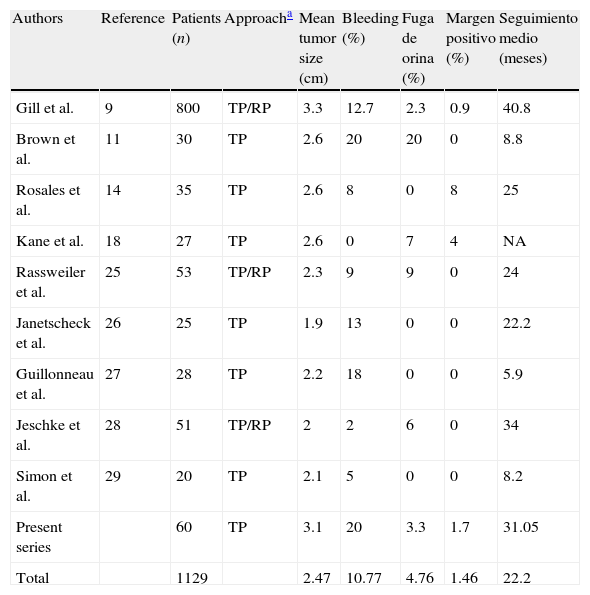To analyze the surgical and oncologic outcome of prospective experience with laparoscopic partial nephrectomy. We describe the surgical technique and mid-term oncological results achieved.
Material and methods60 patients were operated with this technique between June 2005 and June 2009. The mean age of patients was 58.9 [38–77] years, being 40 (66.7%) males and 20 (33.3%) women. The average BMI was 26.8 [18–40]. Laterality was 28 (46.7%) right tumors and 32 (53.3%) left, being located in the upper pole in 14 (23.3%) patients, in the middle third in 13 (21.7%), in the lower pole in 22 (36.7%), and hiliar region in 11 (18.3%). In 23 cases (38.3%) tumors were located in the anterior valve, in 24 (40%) in the posterior valve, in 10 (16.7%) at the outer edge and 3 (5%) at the inner edge. The average size tumor on CT was 3.3 [1–6.4] cm and in the surgical specimen 3.1 [1.2–7] cm.
ResultsThe mean operative time was 107.17 [50–185]min, with a warm ischemia time of 33 [0–70]min. In 56 cases (93.3%) there was a single artery and in 4 (6.7%) cases there were 2 arteries. The artery was clamped alone in 15 patients (25%), artery and vein in 44 (73.3%) and no clamping was performed in 1 (1.7%). We repaired the urinary tract in 32 patients (53.3%), leaving ureteral catheter in all patients. 20% of patients (12) required transfusion. Intraoperative complications occurred in 5 patients (8.7%). These were: 1 splenic injury requiring splenectomy (1.7%), 1 tear in the vena cava, sutured laparoscopically (1.7%) and 3 cases of bleeding due to bulldog malfunction (5%). Postoperative complications occurred in 11 patients (18.7%) and these were: 1 wall hematoma that required reoperation (1.7%), 1 urinary fistula ending in renal atrophy and subsequent nephrectomy (1.7%), 3 intracavitary hematomas which resolved conservatively (5%), 1 arteriovenous fistula that needed embolization (1.7%), 1 urinoma that was resolved with percutaneous drainage (1.7%) and 3 cases of postoperative fever (5%). Margins were positive in 1 patient (1.7%). In 49 cases (81.7%) histology was renal cell carcinoma, in 8 (13.3%) oncocytoma, in 2 (3.3%) angiomyolipoma and 1 (1.7%) metastasis. The average stay was 5 [3–29] days. Median follow up was 31 [12–61] months. There was a local recurrence at 16 months (hiliar primary tumor 2.5cm) and an ipsilateral adrenal metastasis at 34 months (primary tumor 5.6cm in left lower pole).
ConclusionsIn this series of laparoscopic partial nephrectomy low rate of complications, good oncologic results and low recurrence rate in the short term are shown. More patients and further monitoring is required to strengthen the functional and oncological outcomes of this surgical technique.
Analizar el resultado quirúrgico y oncológico de una experiencia prospectiva con nefrectomía parcial laparoscópica. Se describe la técnica quirúrgica y los resultados oncológicos conseguidos a medio plazo.
Material y métodosFueron intervenidos 60 pacientes mediante esta técnica entre junio de 2005 y junio de 2009. La edad media de los pacientes fue 58,9 (38-77 años), siendo 40 (66,7%) varones y 20 (33,3%) mujeres. El BMI medio fue 26,8 (18-40). La lateralidad fue 28 (46,7%) tumores derechos y 32 (53,3%) izquierdos, localizándose en el polo superior en 14 (23,3%) pacientes, en la zona media en 13 (21,7%), en el polo inferior en 22 (36,7%) y en la zona hiliar en 11 (18,3%). En 23 (38,3%) casos el tumor se localizó en la valva anterior, en 24 (40%) en la valva posterior, en 10 (16,7%) en el borde externo y en 3 (5%) en el borde interno. El tamaño medio tumoral en la TAC fue 3,3 (1-6,4) cm y en la pieza quirúrgica 3,1 (1,2-7) cm.
ResultadosEl tiempo medio quirúrgico fue 107,17 (50-185) minutos, con un tiempo de isquemia caliente de 33 (0-70) minutos. En 56 casos (93,3%) había una sola arteria y en 4 (6,7%) dos. Se realizó clampaje sólo de la arteria en 15 pacientes (25%), de la arteria y la vena en 44 (73,3%) y no se realizó clampaje en uno (1,7%). Se realizó reparación de la vía urinaria en 32 pacientes (53,3%), dejándose catéter ureteral en todos ellos. Precisaron transfusión el 20% de los pacientes (12). Se produjeron complicaciones intraoperatorias en 5 pacientes (8,7%). Estas fueron: una lesión esplénica que requirió esplenectomía (1,7%), un desgarro de la vena cava que se suturó laparoscópicamente (1,7%) y tres casos de sangrado por mal funcionamiento del “bulldog” (5%). Se produjeron complicaciones postquirúrgicas en 11 pacientes (18,7%) y estas fueron: un hematoma de pared que requirió reintervención (1,7%), una fístula urinaria que terminó en atrofia renal y posterior nefrectomía (1,7%), tres hematomas intracavitarios que se resolvieron de manera conservadora (5%), una fístula arteriovenosa que precisó embolización selectiva (1,7%), un urinoma que se solucionó con drenaje percutáneo (1,7%) y tres casos de fiebre postoperatoria (5%). Hubo márgenes positivos en un paciente (1,7%). En 49 casos (81,7%) la histología fue carcinoma renal, en 8 (13,3%) oncocitoma, en dos (3,3%) angiomiolipoma y en uno (1,7%) metástasis. La estancia media fue 5 (3-29) días. El seguimiento medio fue de 31 (12-61) meses. Se produjo una recidiva local a los 16 meses (tumor primario hiliar de 2,5cm) y una metástasis en la suprarrenal ipsilateral a los 34 meses (tumor primario de 5,6cm en el polo inferior izquierdo).
ConclusionesEn esta serie de nefrectomía parcial laparoscópica se demuestra la baja tasa de complicaciones, los buenos resultados oncológicos y la baja tasa de recidiva a corto plazo. Se precisa mayor número de pacientes y seguimiento para afianzar los resultados oncológicos y funcionales de esta técnica quirúrgica.











